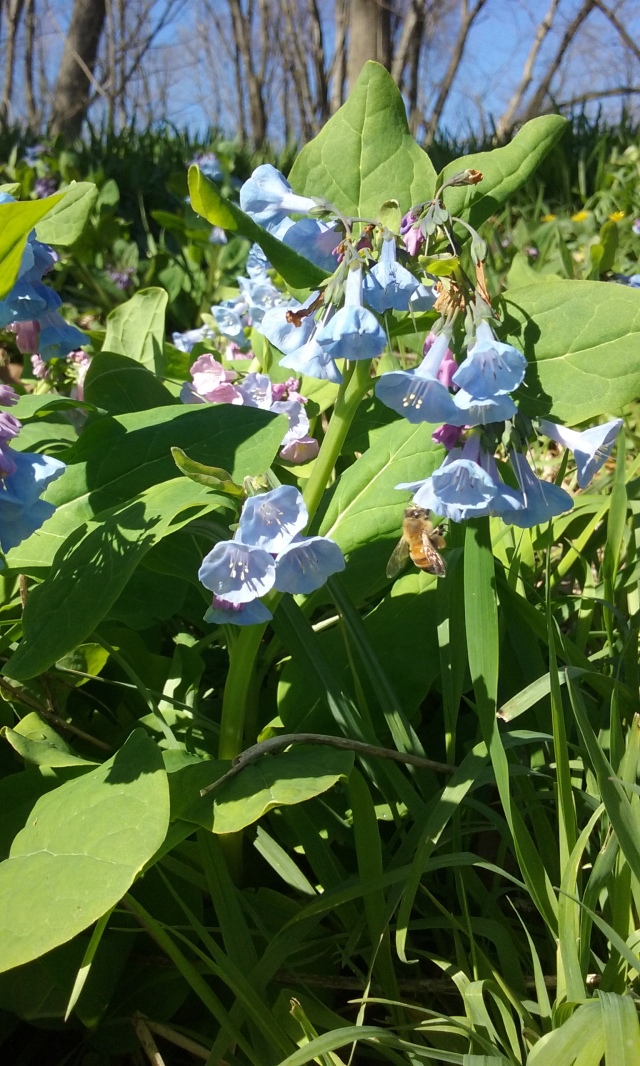
At this time of year, I could take you on a 3-hour flower tour of my favorite Monocacy River island. While you wouldn’t see many species, I would bore you to death amuse you with multiple views of the same flowers, particularly the Virginia bluebells (Mertensia virginica), which nod in clusters of pink, periwinkle, and baby blue, forming a soft carpet over the cool, silty ground. “Look!” I might say, “A bluebell with a bee!”

Or, “Aren’t bluebells colors perfect just before they open?”
Or, perhaps, “Oops! I let go of the leash! Rosie, get back here!”

I get distracted by other flowers, as well. Lesser celandines (Ranunculus ficaria), bright yellow flowers of the buttercup family, are an invasive species that thrive in the riparian environments of Maryland, and, as they appear before any other spring ephemerals, they have an advantage, which you can witness by the fact that they are in nearly every picture that I take of other flowers. For instance, they make a cheerful background for the emerging Trout lily (Erythronium americanum) in the photo that opened this post, and it is their leaves that surround the lovely moss I was photographing when Rosie, set loose by the boys, photo-bombed me. (Yes, she runs off leash much too often, but that grin was just too irresistible for me to get too angry).

Virginia spring-beauties (Claytonia virginica), delicate white-and-pink petaled native flowers, do their best to raise their heads above all of the lesser celandine, and I crouch low, lifting their blossoms to the camera, in order to record their fairy-like loveliness.
Another flower that competes with the lesser celandine is the common blue violet (Viola sororia), which, despite its name, is white as often as it is blue.
Violets are such reliable flowers, as likely to grow in the yard as in the forest, but Toadshade (Trillium sessile) far more elusive. Last year I saw two or three before they faded at April’s end, but this year I’ve counted at least seven, and they’ve all yet to open.
For some reason, perhaps because of their names or concurrent blooming season, I associate toadshade with trout lilies, which also seem to be more numerous this season. The toadshade, of course, would be a distant, smelly cousin, as far as the trout lily is concerned. Despite the emergence of more trout lily leaves, it may still be years before I see a bloom on some of them; trout lilies don’t bloom at all the first 4-7 years of life, when often there is only one leaf sprout instead of two leaves and a flower stalk, as we see here:

Of course, being who I am, no tour along the Monocacy would be complete without pointing out the trash in bloom. It competes with the lesser celandine, too.










Thank you for the bluebell essay! My favorite spring beauty!
LikeLike
They really are wonderful…even the name!
LikeLike
Such a lovely presentation. It is relaxing to view all the pretty colors. Thank you for telling me the names of all the flowers. Such a pretty place!
LikeLike
I’m glad that you enjoyed it!
LikeLike
It was certainly hard to see any trash in these photos… thanks to you.
LikeLiked by 1 person
I suppose that these are among the many wonderful things that make trash gathering worth my while. Thanks for the encouragement!
LikeLiked by 1 person
I love this time of year – beautiful flowers pop up from nowhere colouring our world:)
LikeLike
Exactly, perfectly!
LikeLiked by 1 person
Beautiful pics; especially of Rosie and the flowers 😀
LikeLike
That one is my favorite, too. She looks so happy!
LikeLiked by 1 person
We like happy dogs 😀 ! The ZAB team.
LikeLike